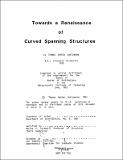Towards a renaissance of curved spanning structures
Author(s)
Hartshorne, Thomas Hunter
DownloadFull printable version (9.754Mb)
Alternative title
Curved spanning structures, Towards a renaissance of
Other Contributors
Massachusetts Institute of Technology. Dept. of Architecture.
Advisor
Waclaw P. Zalewski.
Terms of use
Metadata
Show full item recordAbstract
Today, as always, there is a great need for expressiveness in design. There are a multitude of forms which, over the years, have been stripped from the designer's repertoire in the name of economics. There exists a sub-group amongst the lost forms which can be categorized under the heading, "Curves . " Where have all the curves gone? The Dutch de Stijl and the German Bauhaus movements aid much to make things unpleasant for the curve in the twentieth century. The ever increasing demand for cheap construction methods brought with it a demand for cheap to build forms. Curves have always been more complex to imagine and more difficult to build than straight lines. The appearance of new arches and vaults were common events in the Renaissance. But, since then the demise of the curve has been slow and unrelenting. Curves are now the property of engineers. We see them used in bridges. I do not propose to show how to build arches and vaults cheaper than lintels and flat ceilings. I will, however, restate the structural merits of the curve and show methods for understanding the variety of curves and their relationship to several kinds of loadings. In addition, I present an argument for the union of the curve and the straight line in that modest, but ubiquitous container of humanity, the room; the room with a rectilinear floor plan and a vaulted ceiling. The wedding of these forms has been tried many times before, more often in the more distant than the recent past. Now it is rarely seen, but in a museum or historic building. The juxtaposition of curved ceiling forms and orthogonal floor plans should be revived for it was a lively combination and brought cheer to many.
Description
Thesis (M. Arch.)--Massachusetts Institute of Technology, Dept. of Architecture, 1983. MICROFICHE COPY AVAILABLE IN ARCHIVES AND ROTCH Includes bibliographical references (p. 141-143).
Date issued
1983Department
Massachusetts Institute of Technology. Department of ArchitecturePublisher
Massachusetts Institute of Technology
Keywords
Architecture.